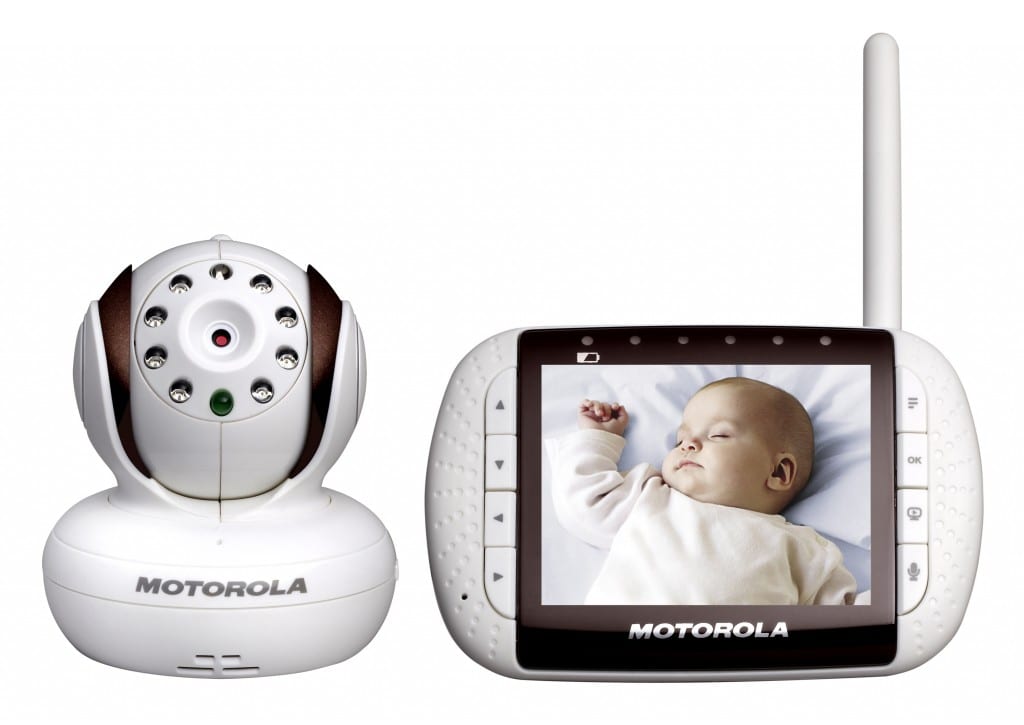Who’s watching the baby? You are—no matter where you are—with today’s high tech video monitors. In our product reviews, we’ve rounded up the best options, so all you have to do is decide.
Long gone are the days when mom and dad had to lie sleepless wondering if they heard a cry or whimper from baby’s room down the hall. Modern moms have a variety of technology to help monitor baby’s every move from the next room or even from the office across town. While that doesn’t mean you can leave an infant alone for any length of time, it does give mom some much needed down time uninterrupted by a need to check on a new baby every five minutes. And for the working mom, leaving her baby at home with a caregiver, some new monitors can provide live video and audio from downtown or across the world thanks to an Internet connection. Sound and image are high quality (though none we tested are HD yet) and some work on private WIFI networks so there’s no fear of broadcasting your lives around the neighborhood to parents with similar devices.
We tested several models from the leaders in the baby monitor business as well as two from companies specializing in home monitoring, Stem Innovation and Lorex Technologies. The IZON from Stem was designed for security monitoring, but because of its design, is a possible option as a baby monitor. After baby gets older, many of these monitors can be used as security monitors, especially those with wireless connections enabling long distance monitoring (of a vacation home, for example).
WIFI and Internet enabled
Most of the monitors we tested now connect to the Internet so you can connect from anywhere you have a connection. Just a few years ago, monitor companies then charged a monthly fee for the connection. All of the monitors we tested provide their ongoing service for free as well as apps to view the video. Some connect via private networks, while a few use SKYPE and other P2P services such as Yahoo! Messenger. Non-WIFI monitors use 2.4GHz digital signals that provide greater privacy than the old –fashioned monitors that provided fodder for nosey neighbors.
Set-up and usage
In our tests, all of these monitors were relatively easy to set up and use immediately. Note that WIFI users will need to know WIFI passwords and some extra steps are required to enable Bluetooth where it is used. We did use the 800 numbers for support on the IZON and the Peek Plus and were impressed by both the ease of solving the problem but also the friendliness of the support staff. They seemed genuinely interested in the personal situation and the importance of fixing the problem for a new parent.
2-Way audio
Some of these monitors have 2-way audio, which was an intriguing feature, but proved to be unnecessary. Our test babies were not soothed by the disconnected voice, and the response made us feel we had to run in faster to attend to the baby. While this might be a fun feature for your future use of the monitor, as an intercom perhaps, it’s not absolutely necessary for the baby unless it makes you feel better about reassuring the baby that “Mommy’s coming.”
Seeing in the dark
Nighttime vision, however was an important feature. Most monitors we tested did have either light-up LED lights or infrared LED lights that are invisible to the eye and illuminate a scene in black and white. Only the IZON showed a completely black screen in a dark room.
Range
While many monitors have 400 foot range and some go all the way to 1000 feet, these numbers may be meaningless for most of us unless you live in a castle. Since the average house length is about 65 feet long, even if you have big 50 foot yards, 75 feet of range from from the middle of the house should be enough. However, the “effective range” is what you need to be concerned about, and that is affected by concrete, metal and other devices, which in certain cases can reduce ranges by 50% or eliminate it entirely. DECT technology was designed specifically for cordless phones and baby monitors and is meant to be more effective with thick or metal walls and with less interference when near other appliances.
Cord safety
The Consumer Products Safety Commission warns parents to be careful with monitors and cords too close to baby. As with curtain cords and other fixed strings, monitor cords are a strangulation risk, especially if they are near an unsupervised baby. While a relatively small number, seven children, have died in these situations since 2002, these are completely avoidable tragedies. The CPSC now recommends that corded devices be kept at least 3 feet away from babies of all ages to avoid risk. Another solution is to choose a monitor that only runs on batteries.
Portability
Most cameras now broadcast to a battery-operated monitoring unit so you aren’t tethered to one room to watch baby. However, the rare purchaser of a camera-only option who doesn’t have a smartphone, will be limited to watching where the computer is.
Finally, it’s very important to reiterate that a monitor is no substitute for a present mom, dad, or other caregiver. You really use a monitor only so you can stay close to baby when you have to be out of earshot. There is no electronic substitute for you when baby cries or in an emergency.
